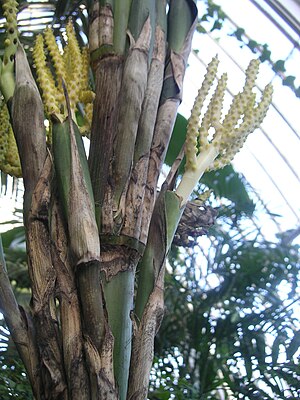Chamaedoreeae
| Chamaedoreeae | ||||||||||||
|---|---|---|---|---|---|---|---|---|---|---|---|---|

|
||||||||||||
| Systematics | ||||||||||||
|
||||||||||||
| Scientific name | ||||||||||||
| Chamaedoreeae | ||||||||||||
| Drude |
The Chamaedoreeae are a tribe of the palm family (Arecaceae). It comprises five very diverse genera.
features
The representatives of the Chamaedoreeae have a very different habitus. The tribe includes stout bottle palms, but also very small species that are among the smallest palms. There are also climbers and those without a trunk. The leaves are pinnate and undivided, the leaflets are almost always pointed and rarely frayed. The leaf sheaths usually form a crown shaft. The palms are monoecious or dioecious separately sexed ( monoecious or dioecious ). The flowers are spherical and stand individually or in triads or in linear windings . The ovary consists of three compartments and contains three ovules . The fruit is almost always solitary, the remains of the stigma are basal.
distribution
Three genera are widespread from Mexico to Peru. Gaussia occurs in northern Central America and the Caribbean, Hyophorbe is endemic to the Mascarene .
Systematics
The Chamaedoreeae as defined by Dransfield et al. (2008) are identified as natural relatives ( Monophylum ) in all studies . Their position within the Arecoideae is still unclear.
Five genera are counted to the tribe, the relationships between which have not yet been clarified:
- Hyophore
- Wendlandiella
- Synechanthus
- Mountain Palms ( Chamaedorea )
- Gaussia
supporting documents
- John Dransfield, Natalie W. Uhl, Conny B. Asmussen, William J. Baker, Madeline M. Harley, Carl E. Lewis: Genera Palmarum. The Evolution and Classification of Palms . Second edition, Royal Botanic Gardens, Kew 2008, ISBN 978-1-84246-182-2 , pp. 369f.